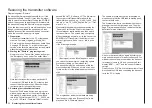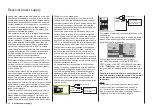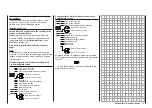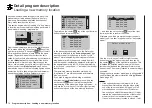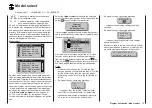
64
Installation notices
Servo mounting lug
Retaining screw
Rubber grommet
Tubular brass spacer
4. Servo arms must be free to move throughout their
entire range of motion. Pay attention that there are
no objects which could hinder servo arm motion.
The sequence in which servos are connected to the
receiver depends on the type of model. Follow the
connection layouts provided for this on pages 73
and 75.
Also observe the safety notices provided on pages
4 … 9.
In order to prevent uncontrolled movements of servos
connected to the receiver during startup
always first switch on the transmitter
and then the receiver
and when finished with operation
first switch off the receiver
and then the transmitter.
When programming the transmitter, be sure that elec-
tric motors cannot start running without control or that
a combustion motor equipped with automatic starting
cannot start up unintentionally. To be safe, disconnect
the receiver’s drive battery or, in the case of a com-
bustion motor, disconnect the fuel supply.
twelve) sockets. A Y-lead can then be used to connect
the corresponding servo.
However, please note that the transverse sockets of
the GR-12 should not be used for the connection of a
receiver battery due to additional voltage losses.
The function of every individual channel is determined
by the transmitter used, not by the receiver. How-
ever, channel assignments can be changed in the
receiver by programming done in the »Tele metry«
menu. However, it is advisable to carry this out at the
transmitter using the »Tx. output swap« option; this
is available as standard on the
mc-20
HoTT trans-
mitter, but has to be unlocked (at extra cost) on the
mc-16
HoTT transmitter; see page 230.
Several notices and suggestions for installing
remote control components into a model are pro-
vided below.
1. Wrap the receiver in a foam rubber pad that is at
least 6 mm thick. Attach the foam rubber to the re-
ceiver with rubber bands so it will be protected
against vibration and/or the jars of a hard landing.
However, do not enclose your receiver completely,
otherwise it may overheat in use.
2. All switches must be installed such that they are
not affected by exhaust gases or vibration. The
switch knob must be freely accessible over its en-
tire range of movement.
3. Mount servos on rubber bushes/spacers with hol-
low brass bearings to protect them from vibra-
tion. Do not tighten the fastening screws down too
tight as this would negate the vibration protection
to be provided by the rubber bush/spacer. Only
when servo fastening screws are properly tight-
ened will this arrangement provide security and vi-
bration protection for your servos. The figure below
shows how a servo is mounted properly. The brass
bearings are to be pushed into the rubber bushes/
spacers from below.
Installation notices
Receiver installation
Regardless of which Graupner receiver system you
use, the procedure is always the same.
Please pay attention that the receiver’s antennas
must be mounted at least 5 cm away from all large
metal parts or any wiring that is not directly routed
out of the receiver itself. In addition to steel parts, this
also includes carbon fiber parts, servos, fuel pumps
and all kinds of cables etc. Optimally the receiver
should be placed at a readily accessible location
that is well away from all other equipment. Under no
circumstances may servo cables be wrapped around
the antennas or routed close to it.
Please note that cables are subject to the accelera-
tion forces which occur during flight and these forces
may cause such cables, to shift in position. Therefore
be sure the cables in the vicinity of the antennas are
not able to move. Such moving cables can cause
reception disturbances.
Tests have shown that a single receiver aerial should
be deployed in the vertical (upright) orientation for
best results during long landing approaches. If your
receiver is an aerial diversity type – two aerials – then
the active tip of the second aerial should be posi-
tioned at 90 ° to the tip of the first aerial, and ideally
the distance between the two tips should be greater
than 125 mm.
If your model features a carbon fibre fuselage, the
aerial tips must always extend outside the fuselage
for a length of at least 35 mm. If this is not possible,
it is essential to substitute longer aerials (300 mm,
Order No. 33500.2, or 450 mm, Order No. 33500.3)
for the standard ones (approx. 145 mm long) fitted to
HoTT receiver(s).
The sockets marked “X+B-” on the HoTT GR-16 and
GR-24 receivers supplied in the sets are intended for
the battery connection. The power supply is passed
through all the numbered sockets, and in principle
the battery can be connected to any of the eight (or
Summary of Contents for HoTT MC-16 Series
Page 1: ...Programming Manual mc 16 mc 20 HoTT 1 en mc 16 mc 20...
Page 27: ...27 For your notes...
Page 53: ...53 For your notes...
Page 61: ...61 For your notes...
Page 65: ...65 For your notes...
Page 71: ...71 For your notes...
Page 103: ...103 For your notes...
Page 107: ...107 For your notes...
Page 111: ...111 For your notes...
Page 155: ...155 For your notes...
Page 165: ...165 For your notes...
Page 201: ...201 For your notes...
Page 229: ...229 For your notes...
Page 231: ...231 For your notes...
Page 261: ...261 For your notes...
Page 265: ...265 For your notes...
Page 301: ...301 For your notes...
Page 327: ...327 For your notes...
Page 328: ...328 For your notes...



